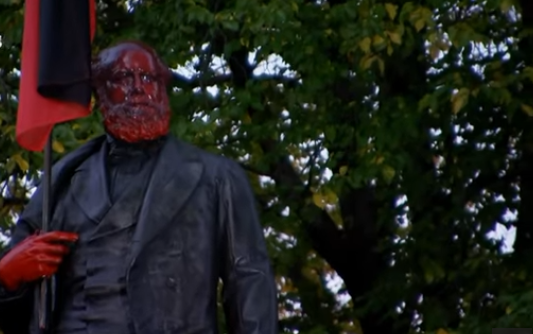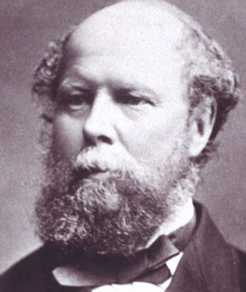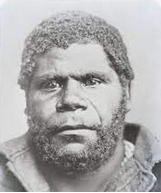
Desecration on the Derwent: Vandalism Billed as Art

Vitalist, unscrupulously optimistic cultures, cruel, bigoted and superstitious, all detest the grace-saving presence of the statue in their midst. — Alexander ‘Sandy’ Stoddart, the Queen’s Sculptor in Ordinary in Scotland
A statue is an embassy of the dead among the living; a conduit for communion between the dead, the living, and those yet to be born. Yet the urge to smash these sentinels of the past has always lurked within us, and a certain type of brutal and temporal person will never pass-up the opportunity to smash a sandcastle, blow up the Buddhas of Bamyan, or chisel a cross into the forehead of the Aphrodite of the Agora at Athens.
This ancient practice has been resurrected during the recent Black Lives Matter conflagrations, which lit a global bonfire of the vanities in response to the killing of a man in Minnesota.
While hooting mobs brandishing iPhones tear down monuments in countries as far apart as Belgium and Barbados, Australia, too, is anxious not to be left behind. In typical Antipodean style, our cringing cultural commissars are experiencing massive FOMO on all the statue-smashing, monument-mashing and cenotaph-scribbling that is going on in those cooler and more vibrant  places across the pond and have come up with their own racial grievance-grenades to hurl at our own heritage.
places across the pond and have come up with their own racial grievance-grenades to hurl at our own heritage.
As part of the City of Hobart’s ‘Aboriginal Commitment and Action Plan’, the statue of former Premier and statesman of Tasmania, William Crowther (1817-1885, right), which stands in Franklin Square, will be “reinterpreted” four times this year in what Lord Mayor Anna Reynolds repeatedly describes as a “conversation” to “promote awareness, discussion and empathy”.
The first of these reinterpretations has just been completed by local artist Allan Mansell, who was commissioned by the city authorities to vandalise Crowther’s statue by pouring fake blood over Crowther’s face and hands, in which he placed a saw and an aboriginal flag while festooning his plinth with defleshed cattle bones. This plinth now also bears a bright yellow plaque which  condemns Crowther for his crimes of “VILE DISRESPECT” and “EMPTY, EGOTISTICAL, BASELESS AMBITION”, while rededicating the monument to William Lanne (left), the last Tasmanian Aboriginal man, whose head Crowther posthumously removed and sent to the Royal Society in London.
condemns Crowther for his crimes of “VILE DISRESPECT” and “EMPTY, EGOTISTICAL, BASELESS AMBITION”, while rededicating the monument to William Lanne (left), the last Tasmanian Aboriginal man, whose head Crowther posthumously removed and sent to the Royal Society in London.
Even at the time, Crowther was suspended from Hobart General Hospital for his well-publicised role in this act of mutilation of Lanne’s corpse, which was a blight on an otherwise successful life of patronage and public service. Among other things, Crowther was a ship surgeon, a parliamentarian, an industrialist, a philanthropist who fought against convict transportation and a doctor who formed the Hobart Town Dispensary and Sick Poor Society, where for three shillings. a month the poor received all the medical attention they required.
Like all men, he was not a total saint nor a total sinner, and this was reflected on his gravestone which bears the engraving; ‘Not ignorant of evil himself, he learned to pity the wretched’.
In ideological times like these, however, the banal “commitments” of second-rate cultural bureaucrats easily sweep-aside such delicate and nuanced sentiments, and no such pity can ever again be allowed to intercede on behalf of those now deemed the historical enemies of Lord Mayor Anna Reynolds’ “progressive council”. Never mind, of course, that they built the place.
Anxious to signal that they are totally listening and hearing our voices, the contemporary guardians of our culture say that such reinterpretations are only opening a “conversation”, but it is a strange dialogue that is conducted by pouring blood over one’s interlocutor, especially when a statue has no chance of talking back.
Yet, of course, the whole point of a statue is that it is not interested in conversation. It is a silent guardian of cultural memory whose unspeaking presence alone is its purpose. It is certainly not a statement of the moral purity of the person they depict and is even less so a billboard for contemporary ‘progressive values’.
Nevertheless, from Akhenaten’s smashing of the monuments of Amun in the 14th century BC to the traffic cone on the head of the Duke of Wellington in Glasgow (now permanently instituted by the city as an official statement of their sense of humour), ‘progressive values’ have always been a justification for petty authorities to destroy the evidence of the past and their relative unimportance.
Anna Reynolds, it is worth noting, is the daughter of academic historian Henry Reynolds, whose writings have certainly provoked a conversation about “awareness, discussion and empathy”, but only for descendants of the Aborigines, and none for the whites who brought to Tasmania the civilisation he has enjoyed all his adult life.
The vandalism of the statue of William Crowther and Franklin Square is a disgraceful and philistine act that is typical of so many substandard cultural bureaucracies who want to show that they are totally relevant and with-it, and of whose original and transgressive acts of iconoclasm the world is now choked full.
In the words of the great contemporary classical sculptor Alexander Stoddart, “this reflex, to remove by one means or another, under one pretext or another, all imagery and every icon, is common to all base-natural peoples, zealots and modernists. It is the job of civilised communities to protect these helpless subjects, not to collude in their expulsion, if not destruction.”
The “Crowther Reinterpretation Project” will run in Franklin Square throughout 2021, and will ‘inform’ the decision to remove the statue permanently. You can have your say on the project here.
Madam: Archbishop Fisher (July-August 2024) does not resist the attacks on his church by the political, social or scientific atheists and those who insist on not being told what to do.
Aug 29 2024
6 mins
To claim Aborigines have the world's oldest continuous culture is to misunderstand the meaning of culture, which continuously changes over time and location. For a culture not to change over time would be a reproach and certainly not a cause for celebration, for it would indicate that there had been no capacity to adapt. Clearly this has not been the case
Aug 20 2024
23 mins
A friend and longtime supporter of Quadrant, Clive James sent us a poem in 2010, which we published in our December issue. Like the Taronga Park Aquarium he recalls in its 'mocked-up sandstone cave' it's not to be forgotten
Aug 16 2024
2 mins







